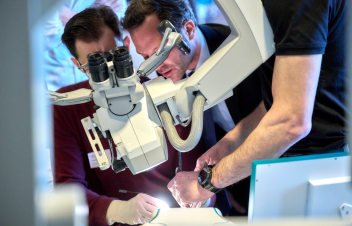Revolutionising Healthcare: The Power of Endovascular and Interventional Radiology
- surgeonslab1
- Jul 5, 2024
- 3 min read
In modern health care, endovascular and interventional radiology (EVIR) has come to the forefront. It provides less-invasive alternatives to traditional surgery. These techniques use imaging to guide instruments through blood vessels, providing precise treatments. EVIR significantly reduces recovery times, lowers complications, and broadens treatment choices.
This article delves into the advances in managing surgical equipment and guiding neurosurgical simulators. It focuses on how important they are to render endovascular and interventional procedures far more effective and safe.

The Evolution of Endovascular and Interventional Radiology
Endovascular and interventional radiology have progressed from early angiography. This involved dye and X-rays to view blood vessels. Now, they focus on less invasive, catheter-based procedures.
Technology has been key in this change. It has been key in imaging, such as fluoroscopy, CT, and MRI. These methods show internal structures in real-time.
EVIR includes three key procedures. First, doctors use coiling to prevent aneurysm rupture by placing coils. Next, they open narrowed arteries with stents. Then, embolisation stops erroneous blood flow, which improves complications such as arteriovenous malformations. These innovations have shifted patient care and led to safer and more effective therapies.
Surgical Equipment Management in Endovascular Procedures
Proper surgical equipment management is crucial for successful endovascular procedures and patient safety. Meanwhile, using advanced imaging systems in the operating room improves precision for navigation and actions.
Hybrid operating rooms with high-definition imaging smoothly switch between imaging and treatments. Inventory systems and tracking tech ensure equipment is ready and well-maintained.
These systems prevent errors, reduce time, and boost efficiency. They help healthcare providers offer better care, making it more accurate and reliable.
Neurosurgical Simulator Guidance: Training and Precision
Neurosurgical simulators are advanced tools. They mimic brain surgery. Thus, surgeons can train safely. These simulators use complex computer models. They simulate real surgical situations. This way, surgeons can practice. They also improve their skills without risking patient safety.
Simulators help surgeons work more accurately and with fewer complications. They can practice and build confidence before real surgeries. This method also supports ongoing education. It ensures surgeons keep up with the latest neurosurgery advancements.
Integrating Artificial Intelligence in Endovascular Radiology
In endovascular and interventional radiology, artificial intelligence (AI) is vital. AI processes data from images quickly and precisely to detect vascular issues at its infancy. It is also used to predict the results for patients, tailor treatments, and improve processes.
AI can process large datasets and improve clinical decisions. It also boosts patient outcomes. Moreover, AI helps robots guide catheters and place stents accurately. This reduces errors and increases the success of procedures.
Patient-Centered Care and Endovascular Procedures
Modern healthcare values patient-centred care. Endovascular radiology fits this by offering minimally invasive procedures. These methods cut hospital stays, pain, and recovery times. This leads to better patient experiences. Plus, it focuses on educating patients and getting their consent. This ensures they know their options and what to expect.
Custom care plans are crucial for the best outcomes. They match each patient's needs and conditions. Also, these plans show modern medicine's focus on patient well-being and satisfaction, especially with endovascular techniques.
Case Studies: Success Stories in Endovascular Interventions
A 55-year-old patient with a brain aneurysm had efficient treatment. They had coil embolisation. Advanced imaging and equipment helped place the coils precisely. This prevented the aneurysm from rupturing. As a result, the outcome was favourable.
For example, doctors used a stent to treat a 65-year-old with peripheral artery disease. They combined imaging systems and careful equipment tracking. This ensured the stent was placed accurately. As a result, blood flow returned to normal. The patient's quality of life significantly improved.
These cases show the importance of managing equipment. They also show the importance of using simulators to guide successful endovascular procedures.
Challenges and Future Directions
Endovascular and interventional radiology have made great strides. Yet, they face challenges. These include high costs and limited access in some areas. Procedures are complex and require special training. However, the future looks bright. Artificial intelligence and robots could boost precision and outcomes.
AI helps in decision-making by analysing lots of data. It predicts patient responses and improves treatment plans. Robots do precise surgeries. They are very accurate. Also, as technology advances, EVIR can greatly change healthcare.
Ending Remarks
Endovascular and interventional radiology have greatly influenced modern medicine. They provide less invasive treatments for complex conditions. Advances in surgical equipment and neurosurgical simulator guidance have boosted both the safety and effectiveness of these procedures.
In the future, we need more innovation and research. This will help us tackle challenges and find new opportunities in the evolving field. EVIR plays a key role. It improves healthcare by enhancing patient outcomes. It also shapes the future of medicine.







